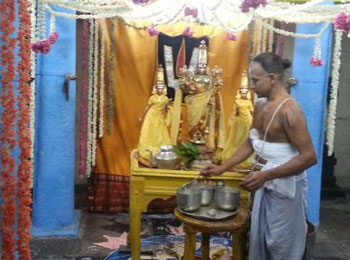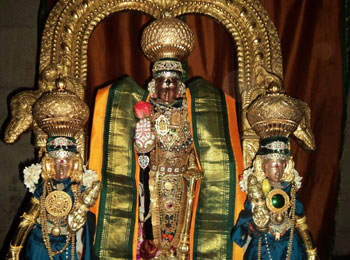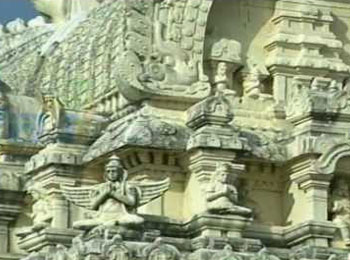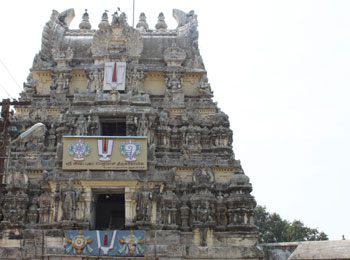- Vishnu
Sri Yathoktakari Perumal Temple
- Ennaikaran,Tamil Nadu
- View on map
- Tell us about this temple
Overview
Kanchipuram is one of the seven sacred cities in India. History proclaims that Kanchipuram was ruled by the Pallava Kings. The city is most famous for its silk production and old temples. The city is located on the Palar river. The city has all types of people from weavers to Vaishnavites. The city has many big temples like Sri Kamakshi Amman Temple, Sri Ekambaranthar Temple, Sri Varadaraja Perumal Temple, Sri Ulagalanda Perumal Temple, Sri Kumarakottam Temple, Sri Kailasanathar Temple, Sri Kachapeswarar Temple and much more. The city also attracts tourist and foreigners in plenty due to its rich culture and heritage. The city has a huge spree of Silk Weavers Society. The city is quite famous all over the world for its Silk Variety and Quality. There is huge demand for export of Silk saris within and outside India. There are many eminent scholars like C.N.Annadurai who were born in this city. The city has developed a niche for the industrial corridors for great giants like Nokia, Motorola, Hyundai and many other. The city also has hotels and restaurants for the comfort of tourist and foreigners. There is a very old Mutt established by Sri Adisankaracharya Called Sri Kanchi Kamakoti Peetam. This mutt is world renowned for its charitable activities and Institutions. There are also other Spiritual mutts within Kanchipuram.
Tiruvekkaa or Yathothkari Perumal Temle situated in Kanchipuram in the South Indian condition of Tamil Nadu , is devoted to the Hindu god Vishnu.considered one of three most established sanctuaries in Kanchipuram, the other two being Ulagalantha Perumal Temple and Pandava Thoothar Perumal kept up and directed by the Hindu Religious and Endowment Board of the Government of Tamil Nadu. considered one of three most seasoned sanctuaries in Kanchipuram, the other two being Ulagalantha Perumal Temple and Pandava Thoothar Perumal initially accepted to be manufactured amid the time of Pallavas. The temple has an arrangement of engravings connected with Cholas. A record of the Chola ruler, Parantaka I (907–950 CE) showing endowment of 367 kalanju of gold to the temple by an individual. The south mass of the focal holy place of the temple has engravings from the period Rajendra Chola I (1012–44) showing blessings of area measuring to one tuni of area and 127 kalanju of gold to the temple. The engravings on the base of the eastern mass of the focal altar from the time of Kulothunga Chola I (1070–1120 CE) demonstrating present for lighting lights of the temple. The southern side engravings of the temple from the time of Kulothunga Chola III (1178–1218 CE) shows an endowment of town to nourish 32 Brahmins.The temple is kept up and controlled by the Hindu Religious and Endowment Board of the Government of Tamil Nadu takes after the conventions of the Thenkalai organization of Vaishnavite custom and takes after vaikanasa aagama.
The temple ministers perform the pooja (customs) amid celebrations and every day. As at other Vishnu sanctuaries of Tamil Nadu, the clerics have a place with the Vaishnavaite group, a Brahmin sub-rank. The temple ceremonies are performed six times each day: Ushathkalam at 7 a.m., Kalasanthi at Each custom has three stages: alangaram (improvement), neivethanam (sustenance offering) and deepa aradanai (waving of lights) for both Yathothkari Perumal and Komalavalli. Amid the last stride of worship, nadaswaram (channel instrument) and tavil (percussion instrument) are played, religious directions in the Vedas (hallowed content) are discussed by ministers, and admirers prostrate themselves before the temple pole. There are week after week, month to month and fortnightly customs performed in the discovers notice in Perumpaanatrupadai composed by Patanjali. There is a notice abou the temple in Silappatikaram (second third century CE), Patanjali Mahabharatham and (third century BCE). The temple is worshipped in Nalayira Divya 7th– ninth century Vaishnava standard, by Poigai Azhwar, Peyalvar, Bhoothathazhwar and Thirumazhisai Aazhwar.The Azhwars have sung acclaim on the distinctive types of Yathothkari peruaml. The temple is named a Divyadesam, one of the 108 Vishnu sanctuaries that are specified in the book. Numerous Acharyas have additionally composed melodies on the different types of God in this Temple. Temple location It is situated in Kanchipuram a kilometre away from Sri Varadaraja Temple. Moolavar is Sonnavannam Seidha Perumal, Yadhokthavari, Veghasethu - Bhujanga Sayanam Facing West. The Thayar is Komalavalli Thayar. The Vimanam is Vedhasaara Vimanam. The Kshetram is Sathyavradha Kshetram. The Theertham is Poigai Pushkarini. It was praised by Thirumangai Alwar with 10 Pasurams. The deity is in an unusual Maaru Sayana Posture.
About The Temple

Sri Yathoktakari Perumal Temple, Kanchipuram, Tamil NaduSri Yathoktakari Perumal Temple is one of the significant Vishnu temples of Kanchipuram. This ancient and the much venerated temple is stationed away in a by lane called Yathoktakari Sannidhi Street of T.K.Nambi road in Chinna Kanchi or Vishnu Kanchi. TheYathoktakari Perumal Temple is located very near to the Ashtabhujasvami temple, about one and a half kilometers west of the Varadarajasvami temple. The place where the temple is stationed is also known as Tiruvehkha. The shrine of Yathoktakari Perumal is one of the oldest in Kanchi and in all of Tamil Nadu as it has been mentioned in the Perumbanattrupadai, a treatise in the Tamil language composed in the Sangam age belonging to approximately 2nd century A.D. The main deity which is placed in the temple sanctum is known as Lord Yathoktakari. According to the common belief a devotee named Yathoktakari accepted the request of Tirumalisai Alwar to follow him out of Kanchipuram, and again return and lie down. The very name of the temple signifies a special meaning.Yathokta means "as requested" and Kari means "a person who did it." Hence the temple is named so following the name of the devotee of Tirumalisai Alwar. The deity which is housed in this temple is eulogized by the early Azhvars or the Mudal Azhvars. The significant Azhvars like Poygai Azhvar and Pey Azhvar and Tirumazhisai Azhvar and Tirumangai Azhvar, have sung the glory of the deity in their hymns. The distinguished Srivaishnava preceptor, Vedanta Desika, has composed a beautiful Sanskrit poem consisting often verses called Vegasetu Stotra in praise of this deity.
Tiruvehkha is also very important to Vaishnavas as it is the birthplace of Poygai Azhvar, one of the famous early Azhvars. The word 'Poygai' in Tamil means tank. Hence the tank in this temple (Poygai Pushkarini) is revered by the devotees as the birth-place avatara-Sthala of this Azhvar. The temple of Yathokta is considered as one of the ancient temples of Kanchipuram, representing antiquity and legendary magnificence at the same time. The traditional importance of the temple is enhanced by the legendary stories associated with the shrine. According to the temple-legend, the common belief runs that Goddess Saraswati intended to spoil the yajna or sacrifice of Brahma at Satyavrata Kshetra which is situated near this temple. She assumed the shape of the swift-flowing river Vegavati to wash away the sacrifice. At this very time, Vishnu, at the request of Brahma prevented the further flowing of Saraswati in the form of a river. He lay down in the path of the river on His serpent Adisesha. Lord Vishnu then put His head on His right arm in the form of a bridge and prevented it from flowing further. The river then disappeared in the underground. As Vishnu lay blocking the course of the Vegavati River, he came to be identified as Vegasethu in Sanskrit and Vekkanai in Tamil.
Architecture of Sri Yathoktakari Perumal Temple, Kanchipuram

The architecture and the sculptural design of the Sri Yathoktakari Perumal Temple, lend it a special significance. The wonderful carvings on the wall of the temple are an added beauty to the antiquity of the legendary temple of Kanchipuram. The main sanctum sanctorum is known as garbha-griha, which is rectangular in shape.
Inscriptions of Sri Yathoktakari Perumal Temple, Kanchipuram

The inscriptions engraved on the temple wall and the pillars surrounding the temples articulate the antiquity and stately magnificence of the temple. The inscriptions on the wall not only enhances the traditional significance, but also helps to determine the actual chronology of the temple.
About the Deity
The main deity Sri Yathoktakari Perumal is lying down in recumbent posture here originally rested with His head on His right hand.
Legend and Stories
The temple-legend narrates the entire episode of how Vishnu later reclined with His head resting on His left hand in this shrine. As the legends connected with the temple state, Tirumazhisai Azhvar lived at this place for some time and with his erudite student, a poet named Kannikannan. The king of Kanchi wanted Kannikannan to compose a poem in his honour. But Kannikannan refused the request of the king. He told the king that having already sung in praise of the Lord, he would not sing in praise of mere mortals. The king became furious with the rejection of Kannikannan. Consequently the furious king banished the bard from the kingdom. As a result of this incident Tirumazhisai Azhvar also decided to go with his student and requested the God to accompany them. The Lord accompanied his disciple as requested and when the trio left Kanchi, the town, bereft of the Lord was covered in darkness. The king understood the mistake he made by passing the verdict to banish the poet Kannikannan. The repentant king, now realizing his folly, requested them to return and the Lord went back to his original place and lay down in his seat. But this time with His head on His left arm to show that He had left the place and returned to it. Thus, Vishnu here is called Yathoktakari (in Sanskrit) and Sonnavannam Seyda Perumal (in Tamil), both signifying the 'one who did as was told.' The place where they spent the short time away from the temple is called 'Oru Trrukkai' or the place where they stayed for one day. It is now called Orikkai, situated very near Kanchipuram. This place also is highly venerated due to its legendary importance. However the legend associated with the temple provide it much popularity among the Vishnu Temples of South India.
Festivals
The festivals performed in the Sri Yathoktakari Perumal Temple, provide it with a majestic grandeur. The festivals of the temple represents the essence of the tradition of the temple. The famous among the festivals performed is the Brahmotsavam festival.
Accessibility
Airport
Well-connected to all important cities of India, Chennai International airport is the nearest airport to holy city Kanchipuram, around 64km away. Taxi services are available from airport to Kanchipuram.
Railways
The city has its own train station and is well-linked with all major cities of India including Delhi, Mumbai and Chennai. Further, Chennai, Pondicherry, and Madurai are the rail lines connected with it.
Road
Regular bus services are available from central cities of the state to Kanchipuram from Chennai (64km), Tirupati (128km), Pondicherry (127km) and Tiruchchirappalli (290km). In-addition, there are sufficient number of bus services available from Kanchipuram to other major cities like Delhi, Mumbai and Jaipur.
Temple Address
Sri Yathokthakari perumal temple / Arulmigu sonnavannam seitha perumal Temple,
Ennaikaran, Kanchipuram,
Tamil Nadu 631501
Significance
Devotees visit this temple to seek fulfillment of the following:-
- Salvation
- Wealth
- Relief from diseases
- Purchase of vehicles
- Gain Knowledge
Shlokas
Achutham Keyshavam Rama Narayanam Krishna Damodaram Vasudevam Harim Shridharam Madhavam Gopika Vallabham Janaki Nayakam Ramachandram Bhajey
Meaning -Oh Lord who cannot be perished, who also has names like Keshava, Rama, Damodara, Narayana, Sridhara, Madhava, Krishna, Ramachandra the beloved of Janaki, let me say your name regularly.
Vasudeva Sutham Devam Kamsa Chanoora Mardhanam Devaki Paramanandham Krishnam Vande Jagathgurum
Meaning -I bow to you O Krishna, the ultimate guru, Devaki and Vasudeva's son, and the destroyer of Kamsa and Chanur.
Adharam Madhuram Vadanam Madhuram Nayanam Madhuram Hasitam Madhuram Hridayam Madhuram Gamanam Madhuram Mathuraa Dhipate Rakhilam Madhuram
Meaning -Meaning - Sweet are Your lips, sweet is Your face, sweet are Your eyes, sweet is Your smile, sweet is Your heart, sweet is Your gait, O Lord of Mathura, everything about You is sweet.
Alokya Mathur Mukha Madarena Sthanyam Pibantham Saraseeruhaksham Sachinmayam Devam Anantha Roopam Balam Mukundam Manasa Smarami
Meaning -I think of this Balamukundan as the one who looks lovingly at his mother's face while taking milk from her, who has eyes similar to the red lotus, who is the embodiment of truth and intelligence and other forms.
